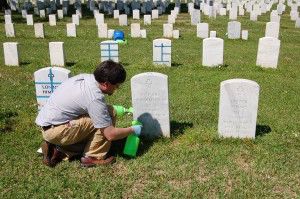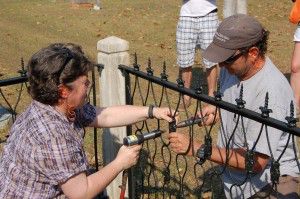NCPTT’s Materials Conservation program works to bridge the gap between laboratory science and real-world historic preservation applications.
Crude Oil and Cultural Heritage
In the spring of 2010, NCPTT staff mobilized in response to the Deepwater Horizon Oil Spill in the Gulf of Mexico. The tragedy of this event shocked many and as response efforts escalated, gaps in understanding of how to treat affected cultural heritage became apparent. While threats posed by crude oil to the natural environment are generally acknowledged, its potential to damage archeological or architectural materials has not been widely studied.
The National Center has been leading the way in research on mitigating damage to archeological materials caused by crude oil. During the summer of 2011, NCPTT intern Erin White undertook a study examining the effectiveness of six different oil removal products on bone and shell. She evaluated the products based on their ability to remove oil without affecting sensitive archeological material. Other considerations included the ease of use and potential environmental toxicity of the cleaners. Results of this study will serve as a guide to archeologists and a basis for future research.
NCPTT used the literature review undertaken for this research as a launching point to develop general guidance for the care of archeological materials contaminated by oil spills in marine environments. This guidance, entitled “Protecting Archeological Objects Contaminated with Crude Oil,” includes treatments for shell, bone, ceramics, glass, metal and wood, and can be accessed on NCPTT’s website.

Katherine Langdon compares poultice recipes for crude oil removal at Fort Livingston, Grand Isle, LA.
In addition to archeological heritage, oil spills can have an adverse effect on the built environment. This past year, NCPTT partnered with the University of Texas at Austin to establish a methodology for evaluating the effectiveness of cleaners used to remove oil from historic masonry. UT graduate student, Payal Vora tested six products for cleaning weathered and un-weathered oil from historic brick as part of her master’s thesis research (available through the University of Texas Library website). NCPTT expanded Vora’s work during the summer with the help of intern Katherine Langdon.
The National Center continues developing methods for evaluating and assessing the adverse effects of oil spills and other disasters on cultural heritage. Mary Striegel, Chief of NCPTT’s Materials Conservation program, is partnering with Dave O’Brien at the City University of London’s Center for Cultural Policy and Management to better understand economic methods for the valuation of damage resulting from disasters. NCPTT also continues its work in the Gulf of Mexico, monitoring conditions at historic Fort Livingston, one of the structures affected by the Deep Water spill.
Honoring National Heroes
National Cemeteries are the final resting places of America’s military heroes nationwide. They encompass a wide range of cultural resources, including sites, landscapes, monuments, and structures. Efforts to maintain a visual appearance that honors veterans while preserving the material fabric of their memorials are equally important. To aid in these efforts, NCPTT released its recommendations for cleaning government-issued marble headstones. This document is the culmination of seven years of research that compared five different commercially available cleaners. Testing was conducted under a mixture of environmental conditions in cemeteries across the country and in laboratories at NCPTT and the Harvard School of Engineering and Applied Sciences. The recommendations describe methods that can remove biological growth and soiling and delay re-growth of microorganisms.
NCPTT has also played an active role in the NPS National Cemetery Task Force. The Task Force recently revised maintenance policies for the operation of fourteen National Cemeteries under Park Service care. This work led to Director’s Order 61, released in July 2010, and the forthcoming companion Reference Manual 61.
Combating Rust
Ornamental iron railings and fences are a common feature on historic structures. However, exposure to the elements can cause these character defining elements to deteriorate over time. Over the past year, NCPTT has undertaken research to evaluate the effectiveness of chemical rust converters for treatment of ornamental iron. Materials conservator Jason Church tested five types of commercially available converters and a custom blend formulated for conservation use. The chemical treatments were applied to samples and monitored while undergoing accelerated weathering. Results of this study were presented at the annual meeting of the American Institute for Conservation in May, 2010, and a full report is forthcoming.
NCPTT is expanding its comparative study of rust converters to include outdoor natural and accelerated weathering in our newly developed weathering facilities. This past summer, Materials Conservation intern Dennis Gibson installed a wireless weather station and outdoor racks for samples undergoing natural weathering on the roof of NCPTT’s Lee H. Nelson Hall. This fall, a solar concentrator that will allow for accelerated outdoor weathering will be installed on the campus of NCPTT’s host institution, Northwestern State University.
Drawing from NCPTT’s study of rust convertors and other conservation research, the National Center offered a two-day training workshop on the conservation of ornamental iron, May 18–19, 2011, in Savannah, Georgia. The event attracted fifteen students, contractors, government employees, and maintenance managers. Participants were exposed to a wide range of skills, from documentation and cleaning to rust conversion and painting. A similar course will be held October 7–8, 2011, in Bloomington, Indiana.
Catering to Underserved Communities
NCPTT continues to offer products to underserved communities. As part of the National Park Service Latino Initiative, NCPTT produced two Spanish language videos on cemetery preservation methods. The videos, “Recolocación Básica de Monumentos” and “Limpieza Básica para Monumentos,” are available on NCPTT’s website. Also, NCPTT produced a video capturing the traditions surrounding burial practices of African-American and Creole community members in the Cane River region as part of our cemetery preservation efforts.



